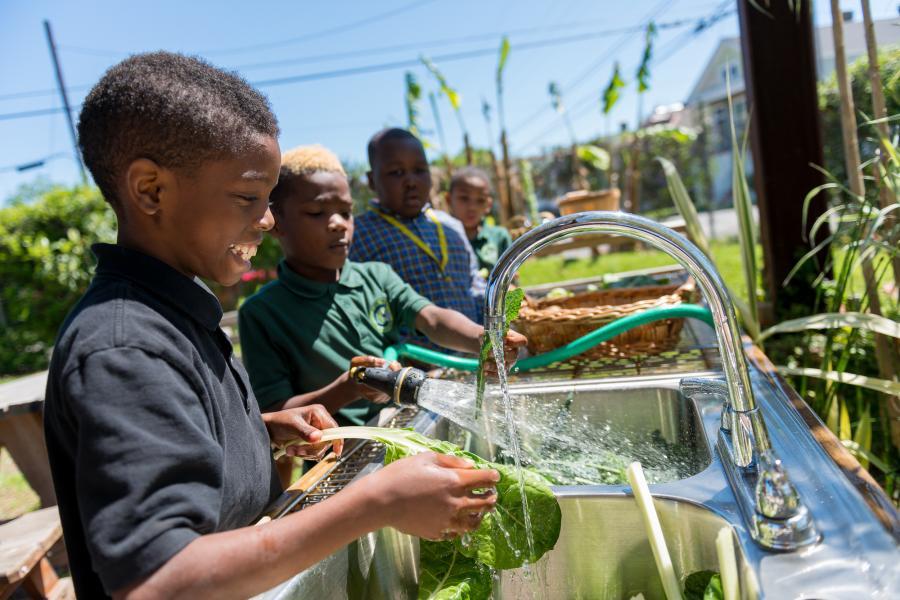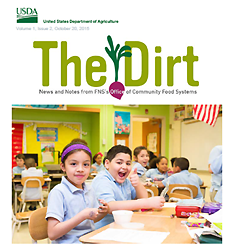|
On September 30, AMS announced awards for four grant programs that work to improve domestic and international opportunities for U.S. growers and producers. These awards include:
The Local Food System Response to COVID-19: Building Better Beyond Webinar Series

Join us on the 3rd Monday of each month for facilitated cross-sectoral discussions on topics related to local food and COVID-19, such as customer retention and engagement, emergency food, cooperative business models, state policies, and consumer behavior. Here is information on the first session scheduled for
October 19:
Title: Marketing Innovations When Communities Eat at Home
Description: This spring as schools sent students home and restaurants closed, supply chains shifted and producers were forced to explore new-to-them markets. During this panel discussion, local food systems leaders will discuss how the pandemic forced the industry to change course. As traditional channels dried up, many producers adopted direct-to-consumer strategies, while others recognized the need for further processing and packaging. Come hear from the National Farm to School Network, the Wallace Center, and the Niche Meat Processor Assistance Network to learn how suppliers shifted to meet consumers at home.
Date: October 19, 2020 at 1:00 p.m. ET
Standardized Farm to Institution Metrics
Under a cooperative agreement between USDA’s Agricultural Marketing Service (AMS) and the University of Kentucky Research Foundation, the National Farm to Institution Metrics Collaborative, which consists of farm to institution leaders from across the United States, developed a suite of farm impact metrics that standardize the reporting of local food purchases by institutions.

Metrics allow practitioners to clearly define the terms of a local purchase and understand the impacts of those purchases. Using consistent metrics means you can track progress over time and ultimately ease barriers for regional food sourcing. Shared metrics allow us to:
- evaluate and compare progress, challenges, and impact across sectors and regions;
- provide more consistency and transparency in reporting; and,
- learn from others in the farm-to-institution world.
The Collaborative recognizes that the benefits of farm to institution are wide, the group has focused on identifying farm impact metrics. The team created an easy-to-use template for tracking the metrics, a protocol guide for using the template, and a short video that walks users through the process.
The project is seeking food system participants that are interested in piloting these metrics in their own tracking and reporting systems. The involvement and engagement of practitioners is important as the metrics are refined.
 Applications due October 30, 2020
U.S. Environmental Protection Agency and USDA invite communities to apply for technical assistance to help revitalize their economy, promote local foods, improve health, and protect the environment. Local Foods, Local Places helps communities revitalize neighborhoods through development of local food systems. To date, 108 communities have participated.
Eligibility: Eligible applicants include local governments, Indian tribes, and nonprofit institutions and organizations proposing to work in a neighborhood, town, or city of any size anywhere in the United States. Special consideration will be given to communities with Opportunity Zone designations.
Application Deadline: October 30, 2020 at 11:59 p.m. ET

Ten years ago, Congress designated October as National Farm to School Month. The resolution recognized the ability of farm to school programs to improve the quality of school meals, create experiential education opportunities, and benefit small and mid-size agricultural producers. The same year, a farm to school program was established within the USDA “to improve access to local foods in schools.”
|
Farm to school has come a long way since 2010. At that time, a little over 9,700 schools participated in farm to school. In 2015, the USDA FNS’s Office of Community Food Systems (OCFS), the entity responsible for overseeing USDA’s farm to school portfolio, counted 42,587 programs in its Farm to School Census. With the soon to be released 2019 USDA Farm to School Census, the number of participating schools is anticipated to be higher. Communities around the country are well-versed in the advantages of farm to school, and in these unprecedented times, home garden kits, virtual agricultural lessons, and local food in school meals and snacks are often the bright point of many students’ days, as well as a market for America’s farmers, ranchers, and fishers.
 In celebration of Farm to School Month, we wanted to highlight several USDA grants that can support you in making the connection between the farm (or boat) and the school plate. The USDA FNS’s Office of Community Food Systems (OCFS) administers the USDA Farm to School Grant Program. The program makes $20,000 to $100,000 available to schools and districts, Indian tribal organizations, agricultural producers or groups of agricultural producers, nonprofit entities, and State and local agencies to help connect students to the sources of their food through education, taste tests, school gardens, field trips, and local food sourcing for school meals.
At AMS, we offer several grants applicable to farm to school.
- The Farmers Market Promotion Program (FMPP) funds projects that develop, coordinate, and expand direct producer-to-consumer markets, including direct producer-to-institution.
- The Local Food Promotion Program (LFPP) supports similar efforts but builds the capacity of local and regional food business enterprises that engage as intermediaries to help increase access to and availability of locally and regionally produced agricultural products.
- State agencies interested in farm to school can apply for the Federal-State Marketing Improvement Program (FSMIP) to help tackle related barriers, challenges, and opportunities in marketing, transportation, and distribution as long as the primary beneficiaries are agricultural producers and agribusinesses.
- The Specialty Crop Block Grant (SCBG) is commonly used for farm to school projects. SCBGs enhance specialty crops' competitiveness by leveraging efforts to market and promote specialty crops, expand availability, and access specialty crops, among other activities.
- The new Regional Food System Partnerships and Micro-Grants for Food Security Program can also support farm to school.
There are many programs across the USDA that can help you connect with this market. While farm to school happens during the school day, it takes ready producers, distributors, and partners to make the program work.
Lettuce Talk Local with an AMS Grant Recipient

For Farm to School Month, we’re highlighting a success story from the Local Food Promotion Program (LFPP). LFPP funds projects that develop, coordinate and expand local and regional food business enterprises to help increase access to and availability of locally and regionally produced agricultural products.
Municipal school districts and other institutions in New Mexico (NM) can now easily stock their kitchens with local foods and produce. They may do so by partnering with Delicious New Mexico, a project developed by the Hispanic-American Institute and Rio Grande Community Development Corporation using FY2017 LFPP grant funding. Delicious NM is an online portal and local distribution service that assists local farmers, ranchers, and food producers in NM with buying, selling, and distributing to new markets. Delicious NM includes an online ordering platform that shows real-time product availability from local producers, reducing delivery timeframes from farm to end-users and providing fresher ingredients.
NM Public Education Department endorsed the online platform. “Schools and school districts are under immense pressure to balance USDA nutrition policy, price point, and quality, and integrating farm to school into their meal programs is a complicated process that is currently fueled by passion and love for children, the land, agrarianism, and our economy. A one-stop online hub for all things local in NM is a positive shift towards institutionalizing farm to school in our state,” said Kendal Chavez, the Nutritionist/Farm to School Specialist at the NM Public Education Department. She expressed that platforms like Delicious NM can help create a system that works for both farmers and institutional buyers while also helping schools provide healthier meals for students.
|
Subscribe to The Dirt, USDA’s Office of Community Food Systems monthly E-letter

The USDA Food and Nutrition Service’s Office of Community Food Systems (OCFS) is an important resource to farm to school stakeholders across the nation. OCFS provides grants, research, and technical assistance. Since the program’s inception in 2013, USDA has awarded over $52 million through Farm to School Grants, funding a total of 719 projects across all 50 States, the District of Columbia, U.S. Virgin Islands, Guam, and Puerto Rico, reaching almost 21 million students in 47,000 schools. Farm to School Grantees and stakeholders create an important web of farm to school leaders across the nation. To keep everyone up-to-date on the latest grantee success stories, research, webinars, and other relevant farm to school news, OCFS publishes a monthly E-letter, The Dirt. To learn more and explore past publications, check out the archives. To receive future editions, subscribe today! Login to your subscription preferences and choose “Farm to School” under Programs.
|
|